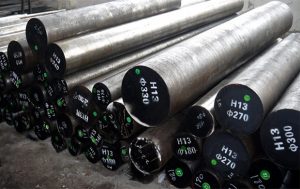
Image Credit: Taybro Alloys Stainless Steel
Carbon is the most important component in commercial steel alloy. Increasing carbon content increases hardness and strength and improves hardenability. But carbon also increases brittleness and reduces weldability because of its tendency to form martensite.
While there are steels that have up to 2% carbon content, they are the exception. Most steel contains less than 0.35% carbon. Now, any steel in the 0.35% to 1.86% carbon content range can be hardened using a heat-quench-temper cycle.
Most commercial steels are classified into one of three groups:
1. Plain carbon steels
2. Low-alloy steels
3. High-alloy steels
1. Plain Carbon Steels
– These steels usually are iron with less than 1% carbon, plus small amounts of manganese, phosphorus, sulfur, and silicon.
– The weldability and other characteristics of these steels are primarily a product of carbon content, although the alloying and residual elements do have a minor influence.
Plain carbon steels are further subdivided into four groups:
a. Low
b. Medium
c. High
d. Very high
a. Low Carbon Steel:
Often called mild steels, low-carbon steels have less than 0.30% carbon and are the most commonly used grades. They machine and weld nicely and are more ductile than higher-carbon steels.
b. Medium Carbon Steel:
Medium-carbon steels have from 0.30% to 0.45% carbon. Increased carbon means increased hardness and tensile strength, decreased ductility, and more difficult machining.
c. High Carbon Steel:
With 0.45% to 0.75% carbon, these steels can be challenging to weld. Preheating, post-heating (to control cooling rate), and sometimes even heating during welding become necessary to produce acceptable welds and to control the mechanical properties of the steel after welding.
d. Very High Carbon Steel:
With up to 1.50% carbon content, very high-carbon steels are used for hard steel products such as metal cutting tools and truck springs. Like high-carbon steels, they require heat treating before, during, and after welding to maintain their mechanical properties.
2. Low-alloy Steels
When these steels are designed for welded applications, their carbon content is usually below 0.25% and often below 0.15%. Typical alloys include nickel, chromium, molybdenum, manganese, and silicon, which add strength at room temperatures and increase low-temperature notch toughness.
These alloys can improve corrosion resistance and be responsive to heat treatment. But the alloys can make it crack susceptible, so it’s a good idea to use low-hydrogen welding processes with them. Preheating might also prove necessary.
3. High-alloy Steels
The stainless steel is the most important commercial high-alloy steel. Stainless steels are at least 12% chromium and many have high nickel contents.
The three basic types of stainless are:
a. Austenitic
b. Ferritic
c. Martensitic
a. Ferritic:
Ferritic stainless steels have 12% to 27% chromium with small amounts of austenite-forming alloys.
b. Austenitic:
Austenitic stainless steels offer excellent weldability, but austenite isn’t stable at room temperature. Consequently, specific alloys must be added to stabilize austenite. The most important austenite stabilizer is nickel, and others include carbon, manganese, and nitrogen.
c. Martensitic:
Martensitic stainless steels make up the cutlery grades. They have the least amount of chromium, offer high hardenability, and require both pre- and postheating when welding to prevent cracking in the heat-affected zone (HAZ).
Steel Classification Systems
Before we look at the common steel classification systems, let’s consider one more high-carbon metal, cast iron. The carbon content of cast iron is 2.1% or more.
There are four basic types of cast iron:
1.
Gray cast iron ,
which is relatively soft. It’s easily machined and welded, and you’ll find it used for engine cylinder blocks, pipe, and machine tool structures.
2. White cast iron,
which is hard, brittle, and not weldable. It has a compressive strength of more than 200,000 pounds per square inch (PSI), and when it’s annealed, it becomes malleable cast iron.
3. Malleable cast iron,
which is annealed white cast iron. It can be welded, machined, is ductile, and offers good strength and shock resistance.
4. Ductile cast iron,
which is often called nodular or spheroidal graphite cast iron. It gets this name because its carbon is in the shape of small spheres, not flakes. This makes it both ductile and malleable. It’s also weldable.